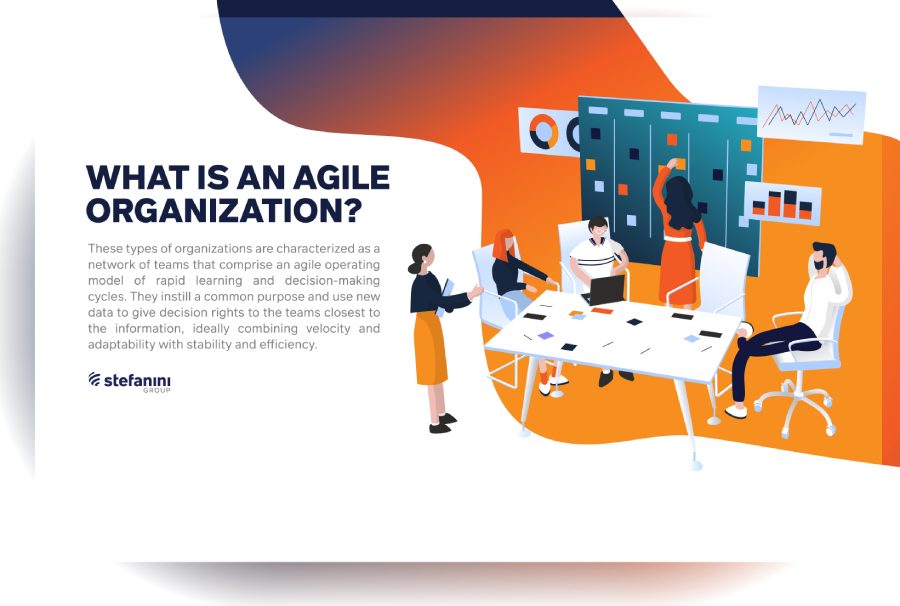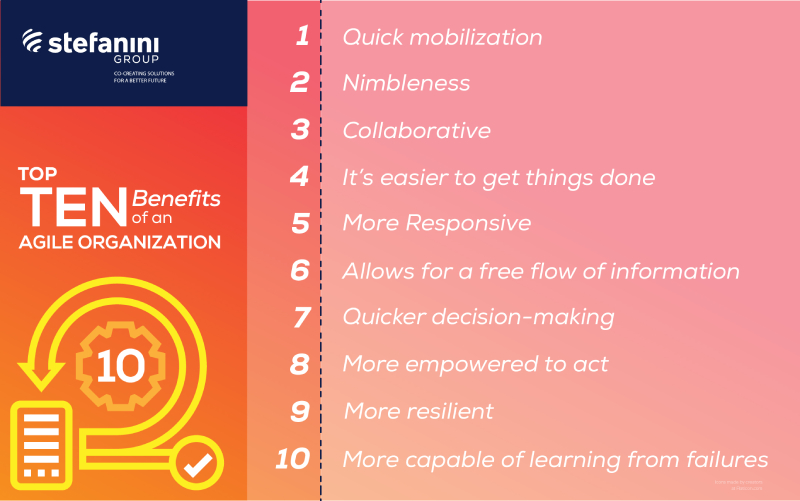Many traditional organizations are catching wind of the benefits that come with being agile. But what exactly does becoming an agile organization mean? Read our Trends blog for the answer!
- What is an Agile Organization?
- Disrupting Traditional Organization Archetypes with New Trends
- Top Ten Benefits of an Agile Organization
- Stefanini’s Agile Methods for Business Innovation
What is agility? Well, the dictionary defines the term as “marked by an ability to think quickly; mentally acute or aware.” It seems that many command and control traditional organizations are catching wind of the benefits that come with being agile. But what exactly does that mean?
To start, let’s by defining the characteristics of a traditional organization. According to McKinsey, these types of companies are typically characterized by being built around static, siloed, structural hierarchy. They place their governance bodies at the top of the organization and decisions made by said leadership flow down their hierarchy.
What is an Agile Organization?

Agile organizations, however, are different. These types of organizations are characterized as a network of teams that comprise an agile operating model of rapid learning and decision-making cycles. They instill a common purpose and use new data to give decision rights to the teams closest to the information, ideally combining velocity and adaptability with stability and efficiency.
So, what are some of the benefits that come with transforming into an agile organization? Read on for the answer!
How can agility contribute to growth? Read this post for more insights!
Disrupting Traditional Organization Archetypes with New Trends
As technology and societies evolve, so do the ways we manage businesses. Specifically, organizational changes brought on by the “digital revolution,” we are seeing a shift in the ways that organizations create and balance dynamism and stability. We see this shift expressed in four current trends:
- Constantly evolving environment: regulators, customers, and partners have pressing needs; all stakeholders’ demand patterns are evolving rapidly; competitors and collaborators demand action to accommodate fast-changing priorities; and investors are demanding growth, which results in acquisitions and restructuring.
- Endless introduction of disruptive technology: established industries and businesses are being replaced or commoditized through bioscience advancements, digitization, automation, and the innovative use of new models. Some examples include technological developments like Internet of Things, machine learning, and robotics.
- Accelerating democratization and digitization of information: the increased transparency, volume, and distribution of information require organizations to rapidly engage in complex collaboration and multidirectional communication with customers, colleagues, and partners.
- The new war for talent: in today’s context, creative knowledge- and learning-based tasks have become more important. As a result, organizations need a distinctive value proposition to acquire – and keep – the best talent, which tends to be the most diverse. Called “learning workers,” these potential hires often have more diverse origins, composition, thoughts, and experience and may have different desires.
These trends are dramatically changing how organizations and employees work, which leads us to the question: how will companies balance stability and dynamism? Further, which companies will attract the best talent and dominate the market?
The answer – which is simplifying the matter – is that truly agile organizations can be both stable and dynamic at the same time. How? It starts with designing backbone elements that slowly evolve and supporting dynamic capabilities that can adapt quickly to new opportunities and challenges. Further, agile organizations mobilize quickly, are empowered to act, are nimble, and make it easy to act. Unlike a static organization, they respond like a living organism.
McKinsey notes that there are three core organizational areas where balancing the tension between stability and flexibility is crucially important: organizational structure, which denotes how resources are distributed; governance, which rules how decisions are made; and processes, which determine how things get done, including managing performance.
Did you know? Stefanini offers virtual agile squads! Learn more here.
Structure
Traditional hierarchies typically denote where work gets done and how performance is measured, as well as who is responsible for awarding bonuses. This process generally involves a boss who oversees work and manages direct reports.
In contrast, agile organizations deliberately choose which dimension of their organizational structure will be their “primary” one. This choice specifies where individuals work or where they are likely to receive coaching and training, as well as where the infrastructure around their jobs is located. On the other hand, day-to-day work, performance measurement, and the determination of rewards are more likely to occur in teams that stretch across formal structures. These crosscutting teams form, dissolve, and reform as resources shift in response to market demands. Sometimes these dynamic teams show up in the org chart, often in the form of market segments, business lines, or product units. Sometimes they don’t, notably in start-up organizational forms.
The main takeaway that agile companies have learned is that the stability of an organizational culture is important because it helps companies to redeploy employees in less successful agile cells more rapidly and easily, with less of the disruption and fear over job losses that typically deter and hinder change. Rather than focus on fixed, short-term projects that have a clear end date, agile organizations recognize open-ended deployment that could last a few weeks or even years. Therefore, functional heads have the responsibility to provide coaching and develop capabilities that allow people to move on quickly to the next opportunity; essentially, opening a new door when an old one closes.
Governance
Agile governance aims to establish both stable and dynamic elements in making decisions, which usually come in three types. McKinsey calls big, high-stakes decisions Type I; frequent decisions that call for cross-unit conversation and dialogue, Type II; and decisions that should be divided into smaller ones and delegated as far down as possible, usually to people with clear accountability, Type III.
Interestingly, Type II topics hinder organizational-wide agility the most. Companies that have successfully addressed this issue pick and choose which decisions are best made in committees and which can be delegated to direct reports and to people close to the daily action. Defined as the stable backbone, they also establish clear charters for committee participants and clarify their responsibilities, avoiding overlapping roles in the process. However, these companies also make quick decisions and adapt to changing circumstances by holding virtual meetings when necessary, dynamically rotating individual members of committees, and spending their meetings engaging in robust discussion and real-time decision making. Thanks to greater clarity about committee-chairing responsibilities and voting rights, it is now easy to convene the core team level or to make urgent decisions virtually and over the phone.
Process
By underpinning the new dynamism with a degree of stability in their structure and governance, agile companies create a stable backbone for key processes. These are usually signature processes, which these companies excel at and can explicitly standardize, but are hard for competitors to copy. When everyone understands how key tasks are performed, who is responsible for what, and how (when it comes to new initiatives) stage gates drive the timetable for new investment, organizations can move quickly by redeploying people and resources across countries, units, and businesses.
Agility suffers when standardization is lacking. In the context of agile teams, approach to management is especially crucial. In many businesses, a top-down strategy guides efforts to realize the CEO’s and top team’s targets, which are passed down the organization to business units, smaller units, and finally, individuals. Along the way, each function, cross-functional team, product group, and territory establishes its own metrics, often in isolation from or at cross-purposes with other departments working toward the same end. As silos are reinforced, dysfunction arises.
Stefanini is ready to deploy agile squads to help your business. Get more information here.
Benefits of an Agile Organization

When it comes down to it, agile companies regularly rethink and when necessary, redesign their structures, governance mechanisms, and processes to find a balance between speed and stability. However, this effort can be daunting for a company that is just starting to become agile. In order to sustain real change, new behavioral norms need to be put into place. This shift doesn’t manifest in merely listing company values; rather, it is a matter of instilling the right kinds of behavior for employees to embody.
Though agile companies seemingly share a few behavioral norms, like the free flow of information and bias for action, other norms vary according to the nature of the company and the specific methods it employs in adopting an agile approach to encourage a healthy, high-performing culture. As these kinds of behavior are more widely adopted throughout all levels and units of a company, it will become easier to change structures, governance, and processes chasing agility.
In summary, becoming agile offers companies the following benefits focused on continuous improvement and offering numerous competitive advantages:
- Quick mobilization
- Nimbleness
- Collaborative
- It’s easier to get things done
- More responsive
- Allows for a free flow of information
- Quicker decision-making
- More empowered to act
- More resilient
- More capable of learning from failures
Stefanini’s Agile Methods for Business Innovation
We are in the midst of a massive digital shift as businesses, across all industries, incorporate new technologies into their companies. Success depends on if your business can stay on the forefront of agility transformation, finding solutions and implementing them quickly. Stefanini Solution Squads allow you to do just that.
At Stefanini, we recognize how design thinking and the agile philosophy can help businesses adapt and thrive in the digital world. We take a dynamic mindset and apply it to all areas of your organization, emphasizing solutions over technology. Stefanini Agile Solution Squads deploy with the right complement of talent, including strategic thinking, problem-solving and design skills, capitalizing on our broad digital ecosystem of professional experts. Interested in seeing how we can deploy agile methodologies at your business? Chat with an expert today!



















